A Physics Comparison of Great Throws From Years Past
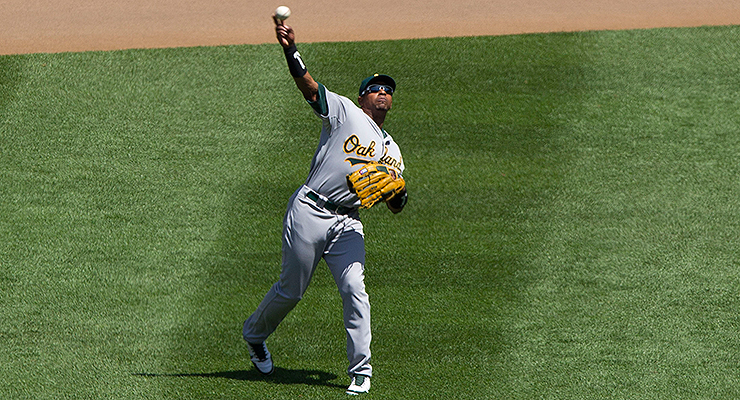
Just how good was that throw from Yoenis Cespedes? (via Keith Allison)
A couple of weeks ago, the baseball world was set ablaze by an incredible throw by Yoenis Cespedes in the eighth inning of a game against the Angels. His impressive throw from the left field corner to home plate was seen by many and ignited comparisons between his arm and many other powerful outfield arms from the past. Most of these debates, however, were based on qualitative and word-of-mouth arguments. What if we could quantify just how good Cespedes’ throw was and compare the qualities of his throw to those of other throws?
Well, we can, as long as we know two crucial pieces of information: time of flight and distance traveled. By carefully analyzing video clips of said throws, I was able to determine the approximate distances and times of flight for each of the throws. To determine the distances traveled I used Google’s distance tool and my best judgment to approximate where on the field the player was. Also, the times of flight were calculated both by counting frames of the videos and by using the tried-and-true method of a stopwatch. Once those parameters were determined, I used Alan Nathan’s trajectory calculator to estimate the launch angle and speed of each of the throws. In using that tool, some assumptions were made and kept constant when analyzing them all. The drag coefficient (Cd) was assumed to be 0.350 and spin rate to be 1500 rpm. Also, I estimated that all of the throws were released from 6 feet above the ground. These parameters play some role, albeit not a very important one in determining the trajectories of the throws. Finally, the correct elevation of the stadium was used in the calculator, which has an effect on the several throws occurring in Denver.
Now, onto the throws. All of these great arms are from the last 15 years primarily because there is reliable and clear video of them so that the time and distance could be determined relatively easily. I wished to study Dave Parker’s throw from the 1979 All-Star Game and Bo Jackson’s laser in 1993, but they occurred at the Kingdome and old Yankee Stadium respectively. Sadly, neither of these stadiums are still standing today therefore I am unable to calculate the distances with Google’s distance tool. (Come on, Google! You have self-driving cars but you can’t go back in time 35 years and take pictures of baseball stadiums?)
Yoenis Cespedes, June 10, 2014
First off is the throw that sparked the debate. Yoenis’ cannon has already been analyzed in-depth by Alan Nathan in a recent Baseball Prospectus article. He found that the ball was in the air for 2.80 sec and flew 300 ft. My analysis corroborated his findings. Given these parameters, he found that Cespedes released the ball at 101.5 mph and at an angle of 10.0 degrees. The trajectory is shown in the plot. In this plot and all others, the red dots show the position of the ball in half-second intervals and the bar on the right shows the location and height of the ball when it was caught.
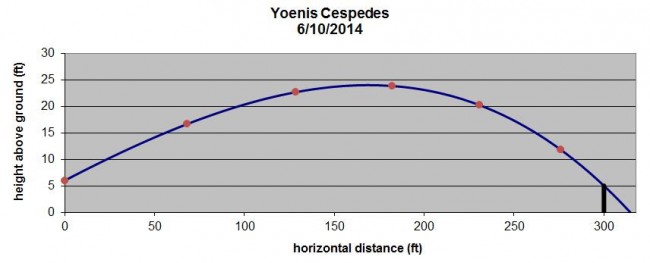
That speed is impressive, but how does it stack up against some of the best throws of the past 15 years?
Yasiel Puig, June 3, 2013
In Yasiel Puig’s first game, he caught a fly ball on the warning track in right field and then fired to first to double off the Padres’ runner and end the game. It was an impressive throw that sparked Puig-mania and gave a new meaning to the phrase “Cuban Missile Crisis”. The wall in right field of Dodger Stadium is measured at 330 feet, but Puig was closer to right center and threw it from the edge of the warning track to first. Based on the video, it appears that the ball is caught by Adrian Gonzalez about 4 feet off the ground after travelling 280 feet. I estimated the time to be 2.56 seconds. Based on that, I found that Puig threw the ball at 100.2 mph and about 8.9 degrees. The trajectory of Puig’s throw is shown below.
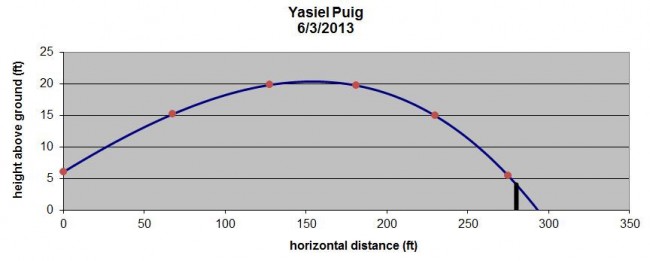
Rick Ankiel, April 16, 2012
Rick Ankiel is a pitcher-turned-outfielder and is well-known for his cannon of an arm. Back in 2012 he delivered a strike on a fly from center to home plate. Jordan Schafer, the Astros’ runner on third, didn’t attempt to go home on the fly ball, but he most certainly would have been out by a mile. Ankiel’s throw hit his catcher Wilson Ramos in the chest about 4 feet off the ground after being in the air for 2.72 seconds and traveling 285 feet. I found that the ball left his hand at a 10.4 degree angle at 97.2 mph.
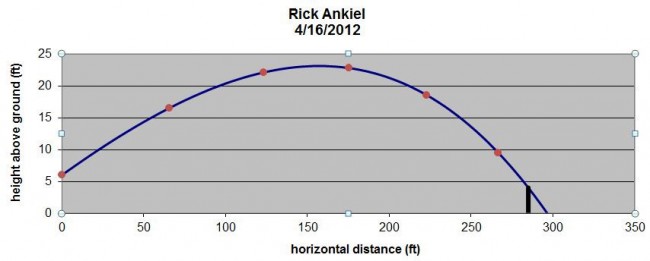
Rick Ankiel, May 7, 2008
In a 2008 game against the Rockies, Ankiel gunned down two runners: Willy Taveras in the 1st inning and Omar Quintanilla in the 8th. The first throw was off a sacrifice fly as he gunned down one of the fastest runners in the game at the time in Willy Taveras (he stole 68 bases that season). Ankiel threw the ball to Troy Glaus at third from 280 feet away and Glaus caught it only about a foot off the ground. I estimated that the ball was in the air for 2.57 seconds. From these parameters, he released it at an angle of 10.4 degrees and a speed of 95.2 mph.
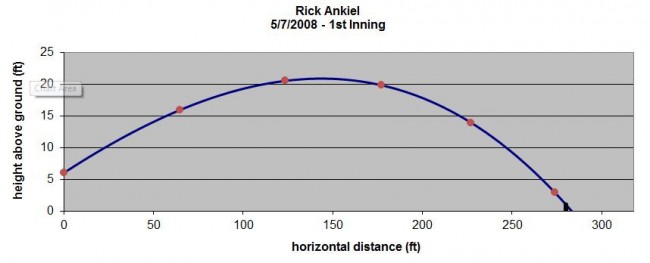
The second throw was from deep on the track in left-center and again went all the way to Troy Glaus to nab Quintanilla trying to stretch a double into a triple. Impressively, Glaus has to reach up to catch the ball approximately 7 feet off the ground when the ball got to the base. According to the video, Ankiel’s throw traveled 325 feet in only 3.10 seconds, which means he released it at 97.4 mph and at an angle of 14.3 degrees.
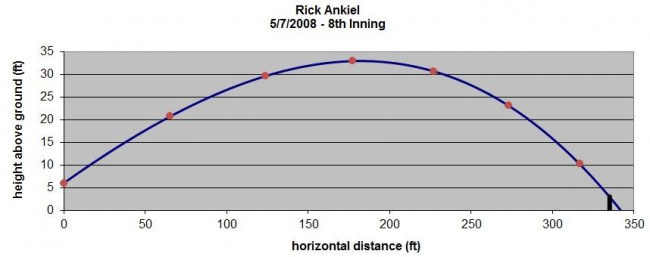
Ichiro Suzuki, April 11, 2001
Ichiro burst on the scene in 2001, winning both Rookie of the Year and AL MVP, but the highlight of that season could be this throw. His throw nailed Terrence Long as he tried to go from first to third on a single to right. Ichiro had a head of steam behind the ball as he threw it approximately 215 feet right to the bag. I estimated that the ball was only in the air for 1.93 sec. Therefore, the ball left Ichiro’s hand travelling 94.2 mph but at an astonishingly low angle of 5.9 degrees.
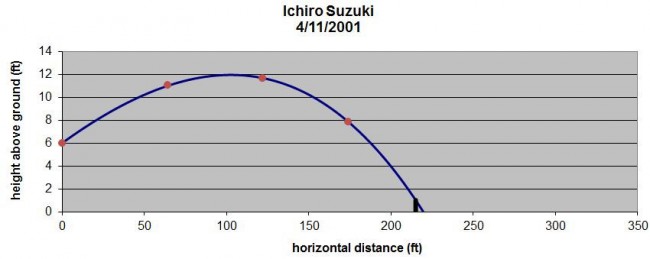
Vladimir Guerrero, July 7, 2001
Vladimir Guerrero is known for his bad-ball hitting, but also for his incredibly strong arm. On this throw, Guerrero throws Alberto Castillo out at home after fielding a base-hit in right-center. I estimated that the ball was in the air for 2.74 seconds and travelled 295 feet. Using these parameters, I then found that Guerrero released the ball at 100.6 mph and an angle of 9.1 degrees.
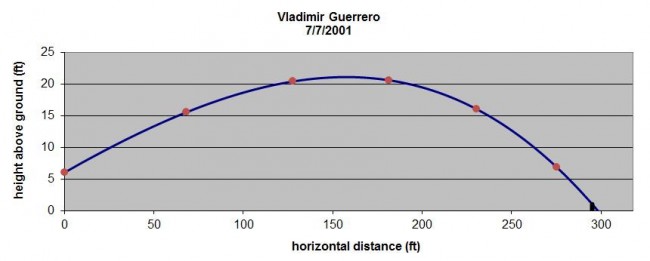
Jose Guillen, April 27, 1998
Last, but not least, a throw that many regard as one of the best ever: Jose Guillen’s incredible throw from the right field track to third base to rob Neifi Perez of a triple. The ball arrives at third base about 3 feet off the ground and in enough time for Perez to be out by a couple of steps. I estimated that the ball traveled 335 feet in 3.05 seconds. According to these numbers, Guillen had to have released the ball at 101.6 mph and an angle of 12.2 degrees.

Comparison
The table below summarizes all of the information presented above for easy comparisons. Note that the average horizontal speed is just the distance divided by the time.
| Comparing the Great Throws |
|---|
| Player | Date | Ballpark | Distance (ft) | Time (sec) | Avg Horiz Speed (ft/s) | Catch off ground (ft) | Release speed (mph) | Release angle (degrees) |
| Yoenis Cespedes | 6/10/14 | Angels Stadium | 300 | 2.80 | 107.1 | 4 | 101.5 | 10.5 |
| Yasiel Puig | 6/3/13 | Dodger Stadium | 280 | 2.56 | 109.4 | 4 | 100.2 | 8.9 |
| Rick Ankiel | 4/16/12 | Nationals Park | 285 | 2.72 | 104.8 | 4 | 97.2 | 10.4 |
| Rick Ankiel | 5/7/08 | Coors Field -1st | 280 | 2.57 | 108.9 | 1 | 95.2 | 10.4 |
| Rick Ankiel | 5/7/08 | Coors Field-8th | 325 | 3.10 | 104.8 | 7 | 97.4 | 14.3 |
| Ichiro Suzuki | 4/11/01 | Oakland Coliseum | 215 | 1.93 | 111.4 | 1 | 94.2 | 5.9 |
| Vladimir Guerrero | 7/7/01 | SkyDome | 295 | 2.73 | 108.1 | 1 | 100.6 | 9.1 |
| Jose Guillen | 4/27/98 | Coors Field | 335 | 3.05 | 109.8 | 3 | 101.6 | 12.2 |
Yoenis Cespedes’ throw had the 2nd fastest release speed and the third largest distance. Jose Guillen’s throw is one of the most impressive for its high speed and relatively low angle. Surprisingly, Ichiro’s throw was only released at about 94 mph, which I found to be low considering he had a running start before getting to and throwing the ball. All of the players took some bit of a crow-hop to get their feet under them, but Cespedes’ may have been the smallest. Puig’s throw is also impressive because his momentum was taking him towards the right field line before he adjusted and quickly threw to first.
All of these throws are acknowledged for their speed, distance, and accuracy, but also because they resulted in outs. There may be other better throws simply from a physics point of view, but that have been forgotten because they were unsuccessful. Yoenis Cespedes’ throw may end up being one of the best of the year and one can see that it stacks up nicely against great throws from the past. However, I do not wish to declare a winner; I only hope that this analysis will introduce quantitative arguments into what are normally emotional debates and try to turn pathos into logos.
References & Resources
Thanks to my adviser, Dr. Alan Nathan, for his guidance with this project, and also to Alex Lang for his editing assistance.

The variable scales on the graphs make visual comparison difficult, however it takes little away from a fantastic article.
This. Agree times a billion.
Great article. Not including the units for average horizontal speed is quite confusing. I wasn’t sure how the average horizontal speed could be faster than the release speed.
For reference, Ichiro’s 107 ft/sec throw is 73 mph.
Two things. Why make the graphs with different scales, and why change the units on the average horizontal speed to ft/s after using mph the entire article?
“but also because they resulted in outs.”
Well, according to the umpires. The Puig throw(1) and two of Ankiel’s might not have passed review today, but I think sometimes umpires (like the rest of us) can be impressed enough by a spectacular play to give the benefit of the doubt.
Outside the time frame, but: Roberto Clemente, one-hop to Manny Sanguillen:
https://www.youtube.com/watch?v=0UUy65ZpSP0
I too am confused by how the average horizontal speed can be faster than the release speed.
(1) Note that even though it’s a force play, the first baseman waits to see if he’s going to get the call. He’s not certain, even shows the ball for some reason.
Oh, sorry, didn’t see “ft/s” and thought it was mph.
Because each throw has a horizontal and vertical component. The ball traveled on an arc to the destination, not a straight line. It has a vertical average speed too – height of release to top of arc divided by 1/2 the time traveled (since the arc in some cases did not end at the same height as release, this adjusts slightly too.)
So, the horizontal is feet to the target divided by time it took to get there, thus an average speed (ft) per (sec) for the ball’s flight.
The exit/arrival speed (at the base) is much lower than the initial MPH velocity of the throw just as the arrival velocity of Aroldis Chapman heater is not 105-107MPH at home plate.
He calculated back the release (initial) velocity needed to get the ball on target at the height received at with the distances and times to target. He just didn’t convert MPH back to feet/sec.
It’s a great study of throws. And release angles, etc.
Did something similar with pop-times on catchers, though not as nerdy on altitude parameters as he factored in as physicists are want to do everything precisely.
Close enough for distance covered.
Catcher’s Pop Times
Clemente: Hand timed 3.02-3.06 secs for Clemente’s 1971 Series throw. The ball traveled around 300-5 feet at max, with the hop (298 ft). (It was 309 to the corner and he’s off the wall laterally a bit so I’d say 320 feet to the direct wall behind him. And he’s 15 feet off that. Rough estimates -not concrete.)
He’s likely around where Ichiro and Ankiel are on this list. Good very good and accuracy matters.
Just out of curiosity, what is the relationship between release speed and overall average speed over 60’6″ for a pitcher?
Any chance you could dig up the Bo Jackson throw?
The average horizontal speed is in ft/sec. I apologize for not including the units for that column. The average horizontal speed was calculated by just dividing the distance the ball was thrown by the time of flight.
A pitch thrown at 90 mph has a release speed of 132 ft/sec. If it is released from 55 ft, then it will have an average horizontal speed of about 128 ft/sec using an estimate of .42 sec to get to home.
“A pitch thrown at 90 mph has a release speed of 132 ft/sec. If it is released from 55 ft, then it will have an average horizontal speed of about 128 ft/sec using an estimate of .42 sec to get to home.”
55/.42 = 131 ft/sec. But if a pitch released at 90 mph or 132 ft/sec has an average speed of 128 ft/sec., that implies that it is traveling about 124 ft/sec or 84.5 mph when it reaches the plate. So it loses about 6% of its velocity?
Does the speed of a pitch normally refer to it’s release speed, its average speed, or its speed at the plate? A radar gun measures the speed instantaneously, but where in the flight to home plate is the measurement actually made?
The pitch speed that’s shown during broadcasts is the release speed out of the pitcher’s hand. The Pitchf/x cameras capture both release speed and final speed. And yes, according to Pitchf/x data from last season, pitches lost about 8% of their speed during the flight. This is in line with Robert Adair’s (author of The Physics of Baseball) predicts when he supposes that pitches lose 7-8 mph by the time they reach the plate.
New yankee stadium has very similar dimensions to old yankee stadium, I think your distance estimation would be fine…
FWIW, this website includes pretty detailed park size info if you ever wanted to do some geometry for parks that don’t exist anymore (Kingdome and even the polo grounds included).
http://www.andrewclem.com/Baseball/Stadium_lists.html
Thanks for the link; looks like a handy resource
Is there any chance you could show what Guillen’s throw would have done at sea-level?
Sure thing. At sea-level instead of 5280 ft, I find that Guillen’s throw would have been released at 107 mph and at an angle of 9.9 degrees.
I have heeded some of your suggestions and have made a rough plot that shows all of the throws side-by-side. http://imgur.com/jisWbwV
I now see that this type of plot would have been great to include initially
Wonderful article, analysis, and follow-up. The Ankiel-Nationals throw actually makes me laugh. All the throws are remarkable for various reasons, but that one is just absurd.
Good stuff.
these throws are all rainbows. do you have any proper throws that are on a line that one hop to the destination? Bautista typically throws on a line rather than rainbows.
They’re only rainbows if you assume the graphs are properly scaled on both axes.
I was going by the release angles and graphs…. I think somewhere around 6 degrees should be optimal
Here are some numbers that address your point. Suppose Cespedes threw a one-hopper, with the bounce occuring halfway between 3B and the plate (i.e., 45 ft from the plate), just as an example. To throw the ball with the same release speed (101.5 mph), the launch angle would be 6.0 degrees, the maximum height would be 13.6 ft (more like a “rope”), and the flight time to that point would be 2.22 sec. At that point, the horizontal velocity would be about 92 ft/s. If the ball lost no horizontal velocity due to the bounce, it would take more than 0.5 sec to travel the remaining 45 ft, for a total time of 2.72 sec. The actual time was 2.80 sec. But: (a) It is very unrealistic for the ball not to lose speed on the bounce. In fact, it is likely to lose a large fraction of its speed, perhaps half. And (b), after the bounce, the ball will continue to lose speed due to air drag. From this I conclude that the ball got to home plate quicker by throwing on the fly rather than a one-hopper. Now, this was just one example and I did not do an extensive study. But my gut tells me that the Cespedes throw was already optimum from the point of view of minimizing the time to home plate, given his maximum release speed.
Except that, in your table, Suzuki had the lowest release speed but still ended up having the fastest horizontal speed of all throws. I assume this is due to him having the lowest release angle of all throws….?
ah, I guess he also had the shortest distance to throw…
Bautista also plays on field turf so his throws lose less speed than they would on grass.
It seems like, least on field turf, if the ball is thrown hard with a very low release angle it skips off the turf without much speed lost.
Given that these throws were close to or exceeding 100 mph at release, which I take to be about the limit at which someone can throw, the only way to reach their target on the fly is to give it some loft. If it were possible to throw with higher release speed, then they could have hit the target with a smaller release angle. But assuming that the ball was thrown with as high a release speed as possible, then the ball would not have arrived at the target more quickly with a one-hopper. I investigated that for the Cespedes throw but I suspect the same is true of the others. So, my guess is that the throws Eric has analyzed were released pretty close to optimally. For the Cespedes throw, the thing I found so amazing was the perfect match of release speed and launch angle, so that the ball landed right where it was intended.
I know you’re trying to fit everything on the page, but it really would be nice to look at these throws in their true perspective.
Also, is it only me that’s somewhat skeptical of the release velocity for some of these throws? When only the very hardest throwing pitchers are able to release the ball at 100 MPH or better with a full, controlled windup, how likely is it that outfielders are able to do that? The recent Cespedes throw, for example. He’s even off-balance when he throws, it’s hard to imagine he could have gotten as much into that throw as the hardest throwing pitchers can muster. Maybe he did, but common sense tells me I should be more inclined to think there’s a bit of measurement error.
They only have to make one throw. They needn’t conserve strength. Additionally, a lot of the hardest throwing position players were pitchers at one point and vice versa. Fast twitch muscles for home runs are similar to the fast twitch muscles used for heaters.
its not only that, an outfielder can charge a ball or set up for a throw, a pitcher only gets a rocker step – and a mound.
I agree. The velocities are way off. The best outfielders’ velocity at the point of release sits in the low 90’s. Even when charging and crow-hopping. Not a chance in a million years that Cespedes throw was over 100 mph.
Definitely enjoyed the article (and clips)! I didn’t see anyone else mention the elephant in the room yet. Several of these throws are at Coors Field.
I was thinking the same thing, with 3 of the throws analyzed taking place at Coors. The benefit of exceptionally low frictional resistance to a baseball traveling through the air increases with the distance to the target. While the humidor mitigates the distance traveled by balls off the bat, the effect is a result of the ball’s elasticity, which changes how the ball reacts upon impact with another object (i.e. the bat), but not how the ball is released by someone throwing it.